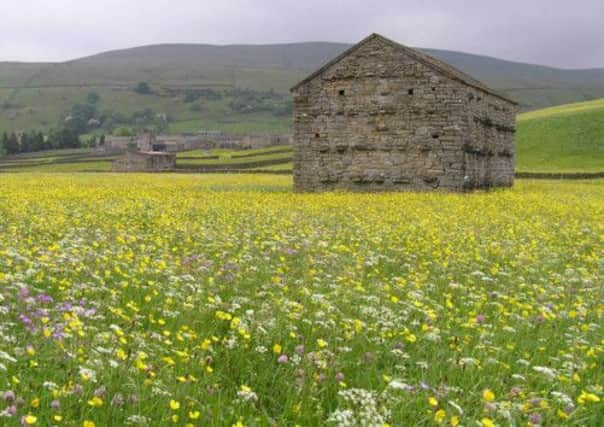TV star backs Dales hay meadow appeal


Some 97 per cent of wildflower hay meadows have been lost in the UK, making them one of the most threatened habitats in Britain.
Organisers of the Hay Time Appeal at the Yorkshire Dales Millennium Trust (YDMT) hope to raise £150,000 over three years to ensure the second phase of a project which began seven years ago and ended in 2011 can continue to restore the visually-striking and wildlife rich habitats. Locally harvested meadow seed has been sown across 300 hectares so far.
Advertisement
Hide AdAdvertisement
Hide AdMr Myers, who lives near Skipton, lent his support at a public event to launch the appeal this week at The Devonshire Arms, Bolton Abbey. The award-winning show garden designer spent four years working at Bolton Abbey as a gardener. Since his departure he has found fame as the presenter of Channel 4’s Wild Things and it was in this role, during filming at Muker, he truly appreciated the beauty of hay meadows, but too few exist as a result of intensive farming, he said.
“The land has been abused to a point where the wildlife has almost gone but the hay meadows have got to be there and that’s why it’s great that these guys are gathering the seeds.”
There were benefits for farmers to convert plots into hay meadows, he said.
“They all need to grow feed for their stock so why not build a meadow and beautify the countryside?” Don Gamble, manager of the Hay Time Project, said farmers had effectively been forced to abandon hay meadows decades ago due to food shortages and the growing competitiveness of food production.
Advertisement
Hide AdAdvertisement
Hide Ad“Since the Second World War there has been a big drive to intensify agriculture so a lot of these habitats have been dug up, reset with fast growing grasses and fertilisers put down for food production. What we’re doing is using the meadows we do have to create more and where this work has been done, the flowers are returning.
“It’s important for the landscape, for wildlife like pollinators such as bumble bees which we know are declining that hay meadows flourish. They’re an important part of our rural heritage.”
David Sharrod, director of the project, added: “This isn’t toy farming. This is real sustainable farming. Increasingly, people are realising we have something special here. People come to this area to see the hay meadows.”
Meat reared on hay meadows is a premium product and selling meadow seeds was profitable, he said.
Advertisement
Hide AdAdvertisement
Hide AdMr Sharrod added: “We reached a position this year when statutory grants dried up. We’re still getting support but if it’s to expand and get better, it needs funding.”
Funding would allow time and resources to be dedicated towards restoring at least another 60 hectares of meadow with the support of the Yorkshire Dales National Park Authority and Natural England.
For more details, visit www.ydmt.org/haytimeappeal